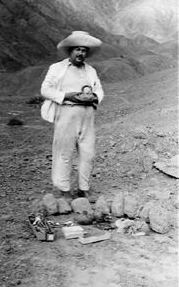Rafael Larco Hoyle facts for kids
Rafael Larco Hoyle (born May 18, 1901, in Chicama Valley, Peru – died October 23, 1966, in Lima) was a very important Peruvian archaeologist. He grew up on his family's farm called Chiclin. When he was twelve, he went to school in Maryland, United States. Later, he studied agricultural engineering at Cornell University. In 1923, he returned to Peru to work on his family's sugar cane farm.
After spending many years abroad, Larco Hoyle saw Peru with fresh eyes. He was curious about the country and soon discovered many ancient cultural treasures on the north coast. He realized these precious objects needed a safe home. This made him dream of creating a museum, like the ones he had seen in the United States.
In 1925, Rafael's father, Rafael Larco Herrera, bought a collection of about 600 ancient ceramic vases and other items. These objects sparked Rafael Larco Hoyle's passion for collecting. Soon after, his father put him in charge of this collection. These pieces became the first part of what would be the famous Rafael Larco Herrera Museum.
That same year, Rafael Larco Hoyle got advice from his uncle, Victor Larco Herrera. His uncle had founded the first museum in Lima. He encouraged Rafael to create a new museum in Lima. This museum would protect the many ancient items that were being dug up by people who weren't supposed to.
Larco Hoyle agreed with his uncle. He wanted to build a lasting tribute to his father, whom he admired greatly. He worked hard to create a museum that would continue his father's legacy. Larco Hoyle bought two large collections: 8,000 pieces from Roa and 6,000 pieces from Carranza. He also bought smaller collections from places like Chicama Valley, Trujillo, Virú, and Chimbote. Within a year, his collection grew a lot. Display cases were set up in a small house on the Chiclín estate. On July 28, 1926, which is Peru's Independence Day, the Rafael Larco Herrera Museum opened its doors to the public.
With the museum open and about 30,000 items, Larco Hoyle started organizing the collection. Peruvian archaeology was still very new back then. Larco Hoyle realized that many types of ancient cultures had not yet been identified. He decided to fix this and began studying archaeology seriously. During the 1930s, he discovered many different Peruvian cultures. These included Viru, Salinar, Cupisnique, and Lambayeque. His main research focus became the Mochica culture. In 1946, Larco Hoyle, who was the director of the Larco Museum, created the first timeline of ancient Peruvian cultures. This timeline is still used today.
Contents
Amazing Discoveries and Contributions
Rafael Larco Hoyle made many important discoveries. He helped us understand the ancient history of Peru much better.
Uncovering New Cultures
Larco Hoyle was a pioneer in finding and defining many ancient cultures. He discovered the Virú culture in 1933. He also found the Cupisnique culture in 1939, including its unique ceramics. In 1941, he discovered the Salinar culture. He also identified the Lambayeque culture, dividing it into two periods. His work showed how these cultures were different from each other.
Understanding Ancient Timelines
One of his biggest achievements was creating a timeline for ancient Peruvian cultures. He found many layers of tombs and buildings. This helped him figure out the order in which cultures lived. For example, he sorted the five periods of the Mochica culture. He also showed that the Huari culture was very widespread. He proved its center was in Ayacucho, not Tiahuanaco as once thought.
Insights into Mochica Culture
Larco Hoyle spent a lot of time studying the Mochica culture. He discovered an early phase of Mochica, which he called Complex Mochica. He also found that the Mochicas used lead and iron. He even suggested that the Mochica writing system had the same origins as the Maya writing.
Studying Ancient Crafts and Tools
He found ancient stone tools used by hunters from the Pre-Ceramics Age. He also discovered that the Chimú people used bricks in their buildings. He learned that the Vicus culture covered copper with silver and gold. He also found that the Chimú culture silvered copper.
Developing a Complete Chronology
In 1948, Larco Hoyle published a very important book. It was called CRONOLOGÍA ARQUEOLÓGICA DEL NORTE (Archaeological Chronology of the North). This book presented a full timeline of cultures in northern Peru. Other archaeologists from around the world have confirmed his findings. His work helped us understand the long and rich history of Peru.
See also
 In Spanish: Rafael Larco Hoyle para niños
In Spanish: Rafael Larco Hoyle para niños


